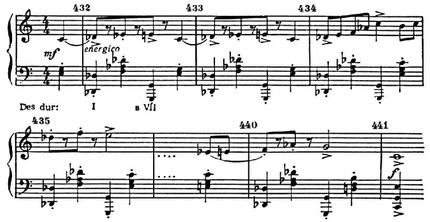
Relationship of keys |
Key affinity – proximity of keys, determined by the number and significance of common elements (sounds, intervals, chords). The tonal system evolves; therefore, the composition of the elements of tonality (sound-stepping, interval, chordal, and functional) does not remain the same; r. t. is not something absolute and unchanging. The principle of R. t., true for one tonal system, may be invalid for another. The multiplicity of R. t. systems in the history of the doctrine of harmony (A. B. Marx, E. Prout, H. Riemann, A. Schoenberg, E. Lendvai, P. Hindemith, N. A. Rimsky-Korsakov, B. L. Yavorsky, G. L. Catuar, L. M. Rudolf, the authors of the “brigade textbook” I. V. Sposobin and A. F. Mutli, O. L. and S. S. Skrebkovs, Yu. N. Tyulin and N. G. Privano, R. S. Taube, M. A. Iglitsky and others) ultimately reflects the development of the tonal system.
For music 18-19 centuries. The most suitable, although not flawless, is the systematics of R. t., set out in the textbook of harmony by N. A. Rimsky-Korsakov. Close tonalities (or those in the 1st degree of kinship) are those six, tonic. triads to-rykh are on the steps of a given tonality (natural and harmonic modes). For example, C-dur is closely related to a-minor, G-dur, e-minor, F-dur, d-minor and f-minor. Other, distant keys are respectively in the 2nd and 3rd degree of kinship. According to I. V. Sposobin, the R. t. system is based on whether the tonality is united by the common tonic of one or another mood. As a result, the tonality is divided into three groups: I – diatonic. kinship, II – major-minor kinship, III – chromatic. kinship, eg. to C major:

In modern music, the structure of tonality has changed; having lost its former limitations, it has become in many ways individualized. Therefore, the systems of R. t., relating to the past, do not reflect the diversity of R. t. in modern times. music. Conditioned acoustic. the kinship of sounds, fifth and tertian relations retain their significance in modern times. harmony. Nevertheless, in many cases of R. t. is associated primarily with the complex of harmonics presented in the structure of a given tonality. elements. As a result, actually functioning relationships of tonal closeness or distance may turn out to be quite different. So, if, for example, in the composition of the key h-moll there are harmonies V low and II low steps (with the main tones f and c), then due to this, the key f-moll may turn out to be closely related to h-moll (see 2- th movement of Shostakovich’s 9th symphony). In the theme of hunters (Des-dur) from symphony. fairy tales by S. S. Prokofiev “Peter and the Wolf”, due to the individualized structure of the tonality (only stage I and the “Prokofiev dominant” – VII high are given in it), the tonic is a semitone lower (C-dur) turns out to be much closer than the traditional dominant of stage V ( As-dur), the harmony of which never appears in the theme.

References: Dolzhansky A.N., On the modal basis of Shostakovich’s compositions, “SM”, 1947, No 4, in collection: Features of D. Shostakovich’s style, M., 1962; Mytli A.F., On modulation. To the question of the development of the teachings of N. A. Rimsky-Korsakov on the affinity of tonalities, M.-L., 1948; Taube R.S., On the systems of tonal relationship, “Scientific and methodological notes of the Saratov Conservatory”, vol. 3, 1959; Slonimsky S. M., Prokofiev’s Symphonies, M.-L., 1969; Skorik MM, Mode system of S. Prokofiev, K., 1969; Sposobin I. V., Lectures on the course of harmony, M., 1969; Tiftikidi HP, Theory of one-tertz and tonal chromatic systems, in: Questions of music theory, vol. 2, M., 1970; Mazel L. A., Problems of classical harmony, M., 1972; Iglitsky M., The relationship of keys and the problem of finding modulation plans, in: Musical Art and Science, vol. 2, M., 1973; Rukavishnikov V.N., Some additions and clarifications to the system of tonal relationship of N.A. Rimsky-Korsakov and possible ways of its development, in: Questions of Music Theory, vol. 3, M., 1975. See also lit. at Art. Harmony.
Yu. N. Kholopov



